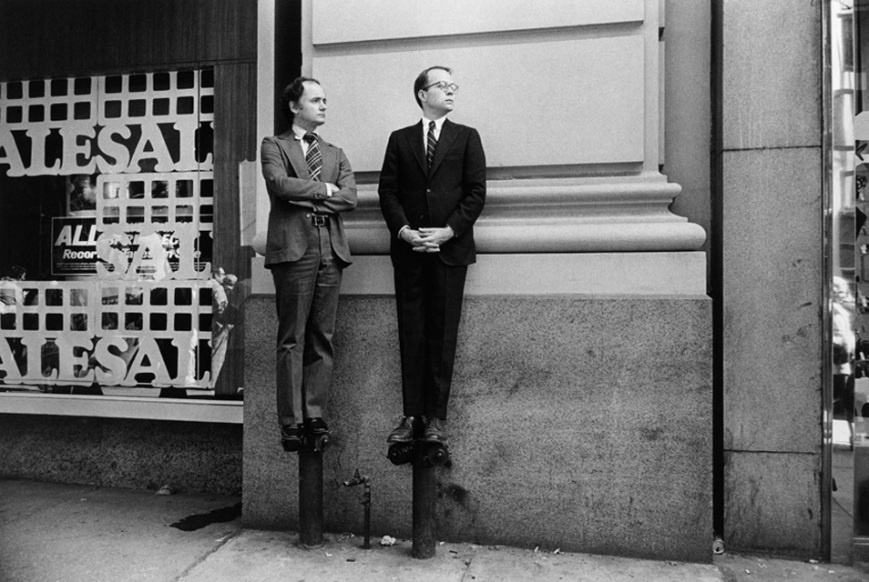
(por Nick Turpin, vía http://www.sevensevennine.com/)
La mayoría de ustedes estarán familiarizados con el extraordinario talento que fue Garry Winogrand, un fotógrafo de calle conocido por su interpretación de América de mediados del siglo 20, que murió en 1984. Winogrand ha sido una enorme influencia en las generaciones posteriores de fotógrafos de calle y ahora hay, como es comprensible, un renovado interés en su trabajo. Winogrand está muy asociado con la fotografía de calle en blanco y negro, pero si que existe una gran parte de trabajo en color en el período 1958-1964, aunque es muy difícil de localizar.
Imágenes en color por la calle de Winogrand han aparecido aquí y allá, la primera imagen a continuación a partir de 1963 se publicó en Bystander, pero las imágenes posteriores nunca han sido publicadas.
En Bystander, Joel Meyerowitz dice:
“Garry también tiró un montón de color, pero por encargo y en los viajes y cosas por el estilo. No lo veía como una fuerza importante.”
Cuando le pregunté a Joel que profundizara un poco en lo que era la relación de Garry con el color, esto es lo que dijo …
“Garry se sentía cómodo con el color y no tenía fuertes sentimientos en contra de ello. Creo que lo utilizó principalmente para su trabajo comercial, dado que frecuentemente llevaba una Nikon con una lente larga para hacer lo que él llamó “sentimentalismo”, que significa en yiddish, graso o sentimental, o dulce, maduro… etc. Por ejemplo, los violinistas que tocan en las bodas por lo general hacen “versiones cursis de canciones de amor.” Pero también llevaba una segunda Leica con color en ella y le encantaba mostrar presentaciones de diapositivas de esa obra, en una ocasión incluso la mostró en el MoMA, cuando John hizo un muestra del trabajo de Garry. Mi conjetura es que, dado que los tiempos no admitían la impresión de color con facilidad, simplemente no veía ninguna razón para enfatizarlo. Tal vez si la impresión a color fuese como es hoy en día, él habría estado pensando en esos términos con mayor frecuencia, pero ¿quién sabe? ”
//
Most of you will be familiar with the extraordinary talent that was Garry Winogrand, a street photographer renowned for his portrayal of mid-20th century America who died in 1984. Winogrand has been an enormous influence on subsequent generations of street photographers and there is now, understandably, a renewed interest in his work. Winogrand is very much associated with black and white street photography but a large body of colour work does exist from the period 1958-1964 but is very difficult to locate.
Single colour street images by Winogrand have tantalisingly appeared here and there, the first picture below from 1963 was published in Bystander but the subsequent images have largely never before been published.
In Bystander Joel Meyerowitz says:
“Garry also shot a lot of color, but on assignment and on trips and things like that. He didn’t see it as a major force”
When I asked Joel to elaborate a little on what Garry’s relationship with colour was, this is what he said…
“Garry was comfortable with color and didn’t have any strong feelings against it. I think he used it mainly for his commercial work as he often carried a Nikon with a long lens on it to make what he called “schmaltz” which means in Yiddish, fatty, or sentimental, or sweet, overripe… etc. For example, violinists who play at weddings usually render “schmaltzy versions of love songs.” But he also was carrying a second Leica with color in it and he loved showing slide shows of that work, once even showing it at MoMA when John did a show of Garry’s work. My guess is that since the times didn’t support color printing very easily he simply didn’t see any reason to emphasize it then. Perhaps if color printing was as it is today he would have been thinking in those terms more frequently, but who knows?”



















Compartir esto // Share this:






























 Garry Winogrand, artista norteamericano, está considerado como un renovador de la fotografía del siglo XX. Durante los años 1960 y 1970 captó la transformación de la mujer y su evolución en la sociedad. La colección Women are beautiful, está formada por 85 fotografías también recogidas por John Szarkowski, director del departamento de fotografía del MoMA, en un libro que recibe el mismo nombre de la exposición.
Garry Winogrand, artista norteamericano, está considerado como un renovador de la fotografía del siglo XX. Durante los años 1960 y 1970 captó la transformación de la mujer y su evolución en la sociedad. La colección Women are beautiful, está formada por 85 fotografías también recogidas por John Szarkowski, director del departamento de fotografía del MoMA, en un libro que recibe el mismo nombre de la exposición. Garry Winogrand, American artist, is considered an innovator of the twentieth-century photography. During the 1960 and 1970 captured the transformation of women and developments in society. Women are beautiful collection is made up of 85 photographs also collected by John Szarkowski, director of MoMA’s photography department, in a book bearing the same name of the exhibition.
Garry Winogrand, American artist, is considered an innovator of the twentieth-century photography. During the 1960 and 1970 captured the transformation of women and developments in society. Women are beautiful collection is made up of 85 photographs also collected by John Szarkowski, director of MoMA’s photography department, in a book bearing the same name of the exhibition.










